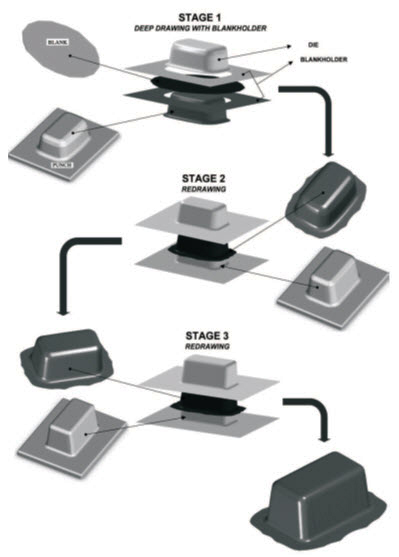Deep Drawing of Aluminum Alloys: Part Two
Abstract
Deep drawing is one of the most intensively studied process areas due to its close relationship with the automotive industry with focus not only on visual appeal but also paramount safety concerns.
However the most important benefit of using aluminum materials in the forming of automotive body parts is the high weight loss factor associated with these materials.
Deep-drawn products are often used for structural elements in the automotive industry. This is why deep drawing is one of the most intensively studied metal forming technologies. Moreover, these products, like for example bodies of cars, are very often important both for the safety considerations and for the visual effect of the final product.
They also considerably influence the weight of the final products, so wherever the technological requirements are met, the producers of deep-drawn parts search for the materials replacing steels, such as aluminum alloys. The use of aluminum alloys is more complicated, not only due to the higher overall costs of aluminum itself, but also due to its properties, making deep drawing of these alloys more difficult.
In recent years, a trend of weight reduction in automobiles is rising from the viewpoint of reducing fuel consumption and exhaust gas emission. Above all, the application of aluminum alloys to automotive body panels is positively considered as a means of effective weight reduction. If aluminum alloy sheets are actually used for automotive body panels, the evaluation of press formability is required in addition to mechanical properties such as strength and ductility.
In sheet steels, it is well known that limiting drawing ratio (LDR) evaluating deep drawability is greatly influenced by the Lankford value expressed by a ratio of true strain in width to true strain in thickness, i.e. r-value (r = dεw/dεt). Similarly, aluminum alloy sheets also seem to show a positive correlation between average r-value and LDR under limited conditions.
Here, when r0, r45 and r90 are r-values at directions of 0°, 45° and 90° to the rolling direction respectively, the average r-value is given by r ̅ = (r0 + 2r45 + r90)/4 conventionally. However, such a correlation has not been clear from experimental results so far, because the average r-value for aluminum alloys produced by conventional rolling and annealing processes generally shows rather lower values than 1 and exists only in a narrow range of 0.55 to 0.85.
The paper of Paćko M. et al. is focused on the multistage deep drawing of AA5754 aluminum alloy box-type part with flange. Both experimental and numerical analysis were performed in this study to predict causes of contraction and cracking occurring in deformed product in respect to the changes of friction conditions on tool-drawn part contact surfaces.
The numerical simulations were performed using eta/DYNAFORM software and LS-DYNA R solver. The research showed, that the results of the simulation are in very good agreement with the results of the real multistage deep drawing processes. Moreover, this study shows, that the proper conditions of friction on the tool-drawpiece contact surface is crucial for the correctness of the analyzed deep drawing process. Too large friction can restrict the material flow, particularly along the edge connecting the bottom and side-walls of the drawpiece, causing wrinkling and cracking.
Figure 4 shows the stages of the modeling performed in this research.

Figure 4: The stages of the modeling of the analyzed deep drawing process
Based on the analysis of multistage deep drawing of a box-type part with flange, made of AA5754 aluminum alloy, the following conclusions can be drawn:
1. The results of the simulation performed using eta/DYNAFORM software are in very good agreement with the results of the real multistage deep drawing processes.
2. Forming-limit diagrams are very important for qualitative analysis of strains at each stage of deep drawing process. In the investigated multi-stage drawing, different areas of the analyzed drawpiece – compared with the results of the numerical simulation combined with forming-limit diagrams – precisely reflect a real behavior of the investigated material in each stage of deformation.
3. The corners of the box-type parts are crucial in respect to the analysis of the investigated deep drawing process. Contraction of the material as well as cracking caused by significant tensile stresses often occurs in these areas of a drawpiece.
4. Proper conditions of friction on the tool-drawpiece contact surface are crucial for the correctness of the analyzed deep drawing process. Too great friction can restrict the material flow, particularly along the edge connecting the bottom and side-walls of the drawpiece, causing wrinkling and cracking.
5. Based on the observations of deep drawing of AA5754 aluminum alloy box-type part in industrial conditions it can be stated, that the friction conditions can be improved both by the application of suitable lubricants and proper selection of the areas of the drawpiece to be lubricated. While lubricating the punch, particular attention should be paid to its corners and edges connecting the bottom and side-walls, but also to drawpiece-tools contact surfaces with special emphasis to the areas of side-walls-flange transition. These observations are partly confirmed by the results of the simulations.
6. An increase of drawing force in the consecutive stages of the investigated multistage deep drawing of AA5754 aluminum alloy box-type part can be observed. It is most probably caused by the reduction of the radiuses of the drawpiece corners as well as by the reduction of the radiuses of side surfaces. Moreover, great ability of AA5754 to strain hardening also significantly influences drawing force.
Access Precise Properties of Aluminum Alloys Now!
Total Materia Horizon contains property information for 30,000+ alumiums: composition, mechanical, physical and electrical properties, nonlinear properties and much more.

Get a FREE test account at Total Materia Horizon and join a community of over 500,000 users from more than 120 countries.